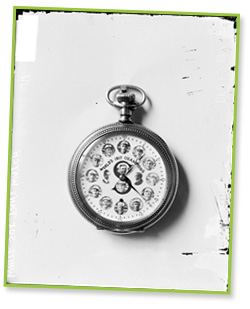A Tough Call
Elementary: Grades 3–4
Story
Page: 1 | 2 | 3 | 4 | 5 | 6 | 7 | 8 | 9 | 10
Dad had also told me that the Sox's owner, Charles Comiskey, had first named his team the White Stockings. But in 1902 they had shortened it to the White Sox. I laughed when Dad laid that news on me. He had laughed, too. "You think that's bad!" he said. "Here's one fact I bet you didn't know, Dan. The very first Chicago team known as the White Stockings wasn't even the White Sox. The first team to use that name was actually today's Cubs!"
I laughed. "Wow, that's unbelievable! And whoever changed it was definitely thinking right!"
Now, I started at the beginning of the first scrapbook, wanting to slowly appreciate every page. On page one, a lone Charles Comiskey trading card stared back at me. Grandma was right. I was diving into a trip back in time, and it was going to be good.
My great-grandpa had saved ticket stubs from games at Comiskey Park on the South Side, too. On one page he wrote that the Sox had originally played at a place called South Side Park, at 39th and Wentworth. But in 1910, Charles Comiskey built a new stadium. That was Comiskey Park, of course.
My team spent 81 years playing there, until it was torn down and replaced by U.S. Cellular Field. As I read about it, I realized that watching home games at "the Cell" put me just across the street from where Great-grandpa Dan had watched the Sox at Comiskey.
Seeing all those ticket stubs made me think again about that fifty dollars. I was as mad at Coach Thomas as everybody else was. With that money I could buy my own tickets, maybe get a new bat, a lot of stuff. Yeah, it would serve Coach right. And we'd benefit, too. I was feeling more and more justified.
Other souvenirs that Great-grandpa Dan had saved included game score books, pennants with players' pictures on them, and a photograph of a commemorative pocket watch from the Sox's 1917 World Series championship. It was all so cool!
But it was the newspaper clippings that really hooked me. Especially the ones about the new players Comiskey brought onto the team in 1915. Like a true fan, I guess, I zeroed right in on the stories about a right fielder named Joe Jackson. Joe, I read, had come up dirt poor from South Carolina. He couldn't even read or write. But when it came to playing baseball, no one could touch him.
"Shoeless" Joe, they called him. The stories said Joe had once played a game in his stocking feet because a pair of new shoes was giving him blisters. Someone in the stands called him a shoeless son of a gun, and people laughed. Joe didn't like it and never went shoeless again. But the name stuck.
As I continued to read, I began to understand why the long-ago White Sox fans idolized Shoeless Joe. He was the team's not-so-secret weapon. The way the reporters described him, Joe was dynamite on that field, with or without shoes. He was the greatest hitter you'd ever want to watch blast a hardball out into space. They said he had a powerful natural swing, made for hitting homers. His ball playing in the field took their breath away, too. The sportswriters made Joe out to be some kind of miracle worker out there on the baseball diamond. I was an instant fan, wishing I'd been around back then to see him play.
Downloads (pdf)


